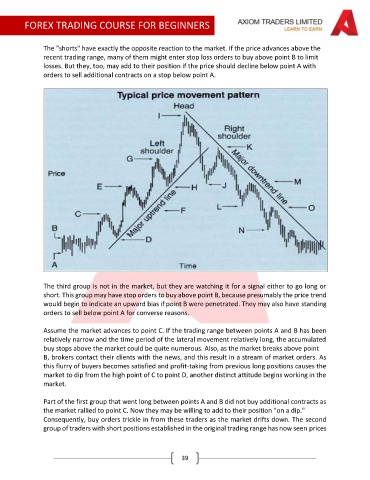Page 39 - NEW FOREX FULL COURSE
P. 39
FOREX TRADING COURSE FOR BEGINNERS
The "shorts" have exactly the opposite reaction to the market. If the price advances above the
recent trading range, many of them might enter stop loss orders to buy above point B to limit
losses. But they, too, may add to their position if the price should decline below point A with
orders to sell additional contracts on a stop below point A.
The third group is not in the market, but they are watching it for a signal either to go long or
short. This group may have stop orders to buy above point B, because presumably the price trend
would begin to indicate an upward bias if point B were penetrated. They may also have standing
orders to sell below point A for converse reasons.
Assume the market advances to point C. If the trading range between points A and B has been
relatively narrow and the time period of the lateral movement relatively long, the accumulated
buy stops above the market could be quite numerous. Also, as the market breaks above point
B, brokers contact their clients with the news, and this result in a stream of market orders. As
this flurry of buyers becomes satisfied and profit-taking from previous long positions causes the
market to dip from the high point of C to point D, another distinct attitude begins working in the
market.
Part of the first group that went long between points A and B did not buy additional contracts as
the market rallied to point C. Now they may be willing to add to their position "on a dip."
Consequently, buy orders trickle in from these traders as the market drifts down. The second
group of traders with short positions established in the original trading range has now seen prices
39

